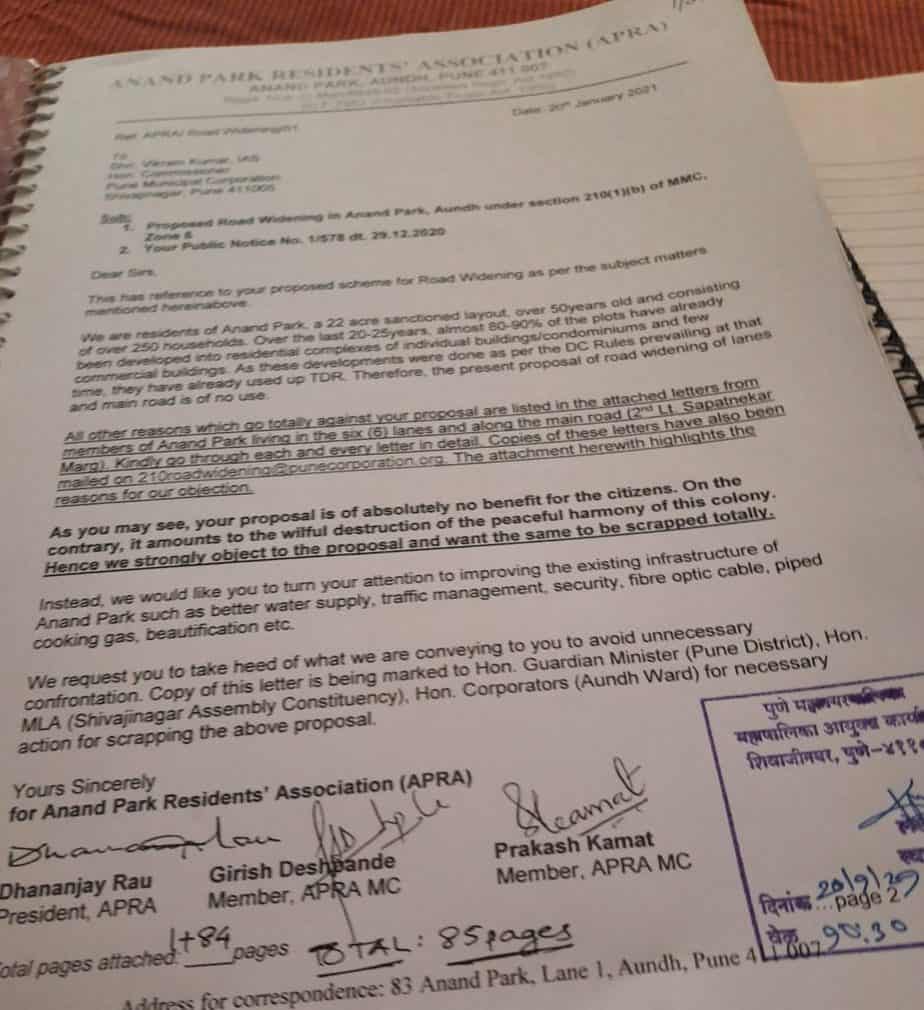“One of our neighbours suddenly saw notices, announcing the Pune Municipal Corporation’s proposal to widen six-metre roads to nine metres and inviting objections within a stipulated time frame, pasted randomly in the lanes of the Anand Park locality,” says Dr Dhananjay Rau, president of Anand Park Residents Association (APRA), a housing society in Aundh. “It took us completely by surprise. Thankfully, we still had time, so we submitted our objections to the PMC.”
The six internal lanes of Anand Park are dead-ends and do not connect to the main road. So why widen the roads, the residents ask. Uncertain utility apart, there will also be an environmental fallout, they argue. “There are about 25-30 trees in each lane and these will have to be axed if the roads are widened,” adds Dr Rau. “We have to consider this environmental impact. Plus widening the main road will lead to more traffic and accidents. So what is the need of this proposal?”
The road widening proposal comes under Mumbai Municipal Corporation Act 1949, section 210 (1) (B) and the time frame is from January 1, 2021 to July 1, 2022. In the first phase, the PMC plans to widen 335 roads out of 2,000 six-metre roads in different parts of Pune.
Coming together
The character of many residential neighbourhoods like Aundh, Sahakarnagar, Bibwewadi, Deccan Gymkhana, Shivajinagar and Peth areas will change if the proposal is implemented. And most residents in these areas are opposed to it, resulting in a few active citizen groups like Anand Park Residents Association (APRA), Deccan Gymkhana Parisar Samiti, Baner-Pashan Link Road Welfare Trust and individual citizens collaborating with each other on how best to get their voices and objections to the project heard.
Read more: Pune: Destroying a hill to build a road of dubious necessity
“One fine day, notices were randomly stuck in neighbourhoods informing people about this proposal,” says Ravindra Sinha, secretary, Baner Pashan Link Road Welfare Trust. “Some people got to know in time, some didn’t. The Baner-Pashan Link Road area where I stay, doesn’t come under the road-widening proposal, but neighbouring areas like Aundh-Baner do. We informed a few active citizen groups there and they submitted their objections in time”.
“Besides sending our objections to PMC, the managing committee of APRA also met Siddharth Shirole, BJP MLA, representing Shivaji Nagar Vidhan Sabha constituency and apprised him of our concerns. We were guided in this matter by Ravindra Sinha,” adds Dr Rau.
While creating awareness and being proactive is necessary, “when you fight with government authorities, it is necessary to create an objective platform, shaped by the law of the land,” says Aneeta Gokhale, executive director of Centre for Development Studies and Activities (CDSA, a research and post graduate teaching institution located in Pune. “We need a logical approach upon which our arguments are based”.
A well thought out technical and legal approach if followed by citizens could boost participatory governance. Though residents of a few co-operative housing societies like Savarkar, Kranti, Sagar, Swananad, Sanmitra, in Sahakarnagar No 2 area have come together to protest against the road-widening proposal, as the move would affect them all, the effectiveness of their protests in getting the authorities to give them a fair hearing needs thought too.
For instance, “we haven’t registered as a citizens group or body yet,” says Dr Anant Bhagwat, president of Savarkar Co-operative Housing Society. “We came together informally to tackle some common issues.” And that is obviously not enough to influence the decision makers.
The objections
Most plot holders and flat owners fear that if the proposal is implemented they would lose their properties and it would lead to traffic and infrastructure issues.
Take the case of Anand Park, which is a 22-acre plot registered under Maharastra Society’s Registration Act in 1997. “It started off as a bungalow plot,” says Dr Rau. “But today most bungalows have been developed into apartment buildings”.
Currently, there are 260 households in Anand Park and they are already facing problems of water shortage and garbage collection. “Many apartment buildings have to pay and get water tankers. Garbage clearance is also an issue. Road-widening which will add to density in these areas will only add to these problems”.
The residents of Deccan Gymkhana (which covers Prabhat Road and Bhandarkar Road) are protesting because under the Town Planning Scheme they already have reconstituted plots.
A well thought out technical and legal approach if followed by citizens could boost participatory governance. Though residents of a few co-operative housing societies like Savarkar, Kranti, Sagar, Swananad, Sanmitra, in Sahakarnagar No 2 area have come together to protest against the road widening proposal as the move would affect them all, the effectiveness of their protests in getting the authorities to give them a fair hearing needs thought too.
Read more: Ministry of Urban Affairs looks to create pedestrian-friendly market places
“But we haven’t registered as a citizens group or body yet,” says Dr Anant Bhagwat, president of Savarkar Co-operative Housing Society. “We came together informally to tackle some common issues”. And that is obviously not enough to influence the decision makers.
Aneeta Gokhale sheds more light on the Town Planning Scheme, under which this road-widening project falls. “Under the Town Planning Scheme, which was finalised in 1927-28, you have notional land pulling, where areas are earmarked for building infrastructure like roads, schools, parks, hospitals.

A road classification and its hierarchy has already been done under the Town Planning scheme, according to Aneeta. According to this classification, internal roads in colonies should be largely traffic-free. “Therefore, it makes no sense to widen the internal roads of lanes and bylanes,” she says.
The Town Planning Scheme is a part of the Maharashtra Regional and Town Planning Act. The first Town Planning Act was implemented in 1915. Then it was known as Bombay Town and Country Planning Act and it was the brain-child of Sir Patrick Geddes, a Scottish biologist. The vision of Town Planning Scheme was to deliver quality, healthy life to residents.
Demographic projections ignored
Aneeta also points out that the PMC hasn’t done any demographic projections. “If you want to increase the density of a certain area, you first need to do a survey if it has the carrying capacity and one measure of carrying capacity is whether you can supply water to the residents of the new buildings that will come up,” adds Aneeta. “There are norms of Government of India (Urban and Regional Development Plans Formulation and Guidelines). Do you have enough space if you add 30,000 more people? Various age groups need various facilities. The URDPFI norms are mandated, but they are not being implemented.”
Dr Anant, who represented Savarkar, Kranti, Sanmitra and Sagar HSGs, attended the hearing called by PMC to hear objections. “We explained the reasons that all the lanes in our society, a residential neighbourhood, were dead-ends,” says Dr Anant, a consultant radiologist. “Savarkar society has 55 bungalows and neighbouring Kranti has 54. The widening of the roads would make it more commercial, it would lead to more traffic and parking mess. Plus, we are located near the Taljai hill and this will lead to encroachment on the hill. The area we live in falls under silent zone, green zone and the hillslope zone. The authorities told us that they would put forward our objections before the Standing Committee.”
For the residents of Sahakarnagar area, the worry is that if the proposal comes through, “we will end up losing the frontage of our properties. Not all of us have the means to move to another area, or buy another flat. And why should we get displaced? The move will only benefit the rich and influential builders,” Anant points out. “We are also considering legal options. This is a wake up call for all the middle class people.”
The protesting residents have also written to state ministers and Union Government. “The residents of Savarkar Co-op Housing Society, Kranti Co-op Housing Society, Sagar Co-op HSG, Swanand Co-op HSG , Sanmitra Co-op HSG and few more — submitted collective letters to Deputy Chief Minister Ajit Pawar and Eknath Shinde, Urban Development Minister, Maharashtra Government. We also met Union Minister of Environment, Forest and Climate Change, Prakash Javadekar and briefed him about the dangerous environmental impact such a move would bring”.
But there is little indication that all this is being taken seriously by the authorities.
Asking the right questions
Not many citizens are aware of how to present their objections. One needs to better articulate the points that ‘here’s why we don’t want it.’ In the case of road widening, one group is in favour because they have got offers from builders for their plots, and another is not. “So it’s important that you get everyone together on the same page and ask the right questions,” says Aneeta.
However, that is easier said than done. “More participation is necessary, and more formal citizen groups are necessary,” adds Ravindra Sinha.“Currently, in Pune, we have about 18,000 registered housing societies. Ideally, every 5 sq km area should have one mohalla group. Or if there is a cluster of societies, hundred is a good enough size to form a housing society welfare association”.
Once a group is formed, members should take up designated roles and tasks. “In Baner Pashan Link Road Welfare Trust, we have a charter, a structure, to address issues of the area like infrastructure, environment and social issues,” says Ravindra. “So everything from roads, water, electricity, river, hills, tree plantation and development plan, amenity space is addressed. But there is a huge disconnect between what the citizen wants and what the authorities plan to do”.

Ravindra also believes that if Area Sabhas are effectively implemented they will foster participatory governance. The Maharashtra Municipal Corporations (MMC) Act amended in 2009 talks about holding Area Sabha meetings. An Area Sabha means constituting a body of all persons registered in the electoral rolls pertaining to all polling booths in the area; the chairperson would be Councillor of the electoral ward concerned and Secretary of Area Sabha would be appointed by the Corporation from amongst its officers not below the rank of Office Superintendent.
“The Mohalla committees are more of a grievance redressal meetings,” adds Ravindra. “The legal provision for holding Area Sabha meetings hasn’t been operationalised in Maharashtra”.
Read more: Potholes, poor lighting and flawed speed bumps: The nightmare on Pune roads
“It is important to hold discussions and meetings, but all of this has to be documented and acknowledged by the PMC”, adds Aneeta. “It is very important for citizens to protest with awareness. Put everything in writing. And ask for an acknowledgement in writing from the authorities, because they mostly don’t want to put anything in writing. Unless you do the documentation, how else will you get the information under Right to Information Act?”
A resident of Ganeshwadi in Deccan Gymkhana, Aneeta and other residents had earlier challenged the civic body’s plan to start a restaurant there. “If you check the Development Control Rules (DCR), it says that Bhandarkar Road and Prabhat Road should not be designated as commercial zones. In Ganeshwadi area, where I stay, the internal roads are around 4.5 metres wide, so no commercial activity should be coming up here. But permission was given to start the restaurant here because the entry or access road was shown as Fergusson College Road. We then collected signatures of Ganeshwadi residents protesting against the restaurant; we showed the officials the DCR, and were able to prevent the restaurant from stepping up.”
The moral of the story: its difficult, time consuming and hard work. But if the citizens are aware and understand the rules and laws, they can get their voices heard.
Also read:
